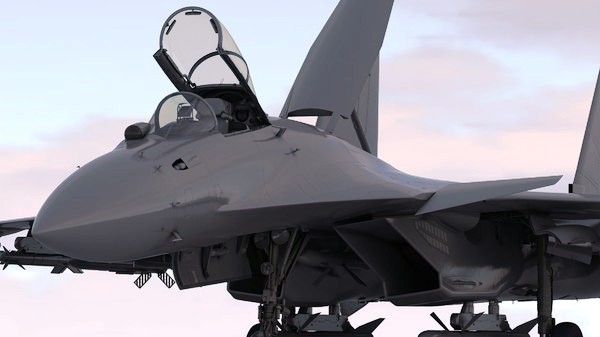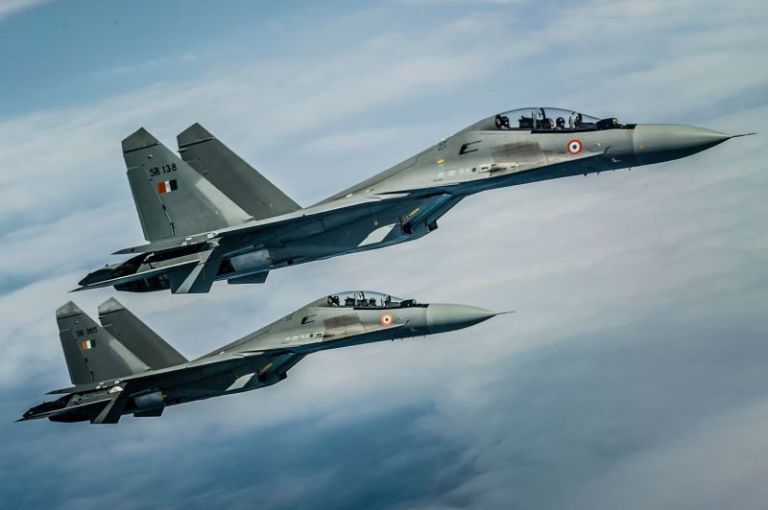A pair of Indian Air Force Sukhoi 30 MKIs. Source foxtrotalpha.jalopnik.com
When the Indian Air Force selected the Sukhoi 30 in the late 90s, as their new multirole/ air superiority fighter, the top brass weren’t initially impressed and insisted that they get more than the usual watered down hardware that the newly formed Russian Federation normally provided until then. The envisioned fighter would soon be called the Sukhoi 30 MKI (M- Modernized K- Commercial I- Indian) and in the years to follow, it would prove its mettle both in India and abroad.
When the Irkutsk Aircraft Production Association, now called the Irkut Corporation (UAC), handed over the first batch of 10 Sukhoi 30 MKIs to the Indian Air Force in 2002, it was a pioneering aircraft of sorts because it had a number of firsts to its name. Some of the more important features were that though the airframe and propulsion units were Russian, it had for the first time, what was termed an “International Avionics Suite” meaning that the avionics was made by almost 14 different foreign firms from 6 different countries! Though that might not sound like much today, it was huge back then. The “no holds barred” international market was just getting its feet warm after a very long cold war, and here you have a state of the art Russian aircraft, with Russian engines, using Western, Israeli, Russian, South African and Indian avionics and sensors and expending Russian, Israeli and Indian munitions!
Another distinctive and pioneering feature was that the Sukhoi 30 MKI was the first production aircraft to be fitted with propulsive units having thrust vectoring control (TVC). The Lyulka AL-31FP turbofan engine (developed by RDC) and a remote control system were integrated into a single control loop to provide two dimensional thrust vectoring control. The technology onboard the Sukhoi 30 MKI was what could best be described as a fusion of both the Sukhoi 30 and the Sukhoi 37 programs. The mission computers and related hardware were completely indigenous with elements of European and Israeli hardware. The Tarang RWR system package was another example of seamless integration between systems from different suppliers. With the addition of the iconic canards to improve aerodynamic performance, the transfromation was complete and the Sukhoi 30 MKI became instantly recognizable from its predecessors. Such was the impact, that the PLAAF, not to be outdone ordered around 50 Sukhoi 30 MKKs from Russia. The Sukhoi 30 MKK vastly varied from the MKI on various parameters. Simply put, the MKK was lighter and less advanced than the MKI.
In October 2000, a MoU was signed between the Irkut Corporation (UAC) and HAL confirming license production of 140+ Sukhoi 30 MKIs, with the first aircraft rolling out of HAL’s hangar in November 2004. From MFDs to mission computers, with every new batch, the level of indigenisation kept increasing.
While it was the Chinese who were left in the dust, to play catch up during the late 90s, we find the Indians in the same position today. Though the final agreement hasn’t been signed yet, it is speculated that the Russians and the Chinese have ironed out most of the finer technical details on the deal to purchase 24 Sukhoi 35S’. This triggered a sense of urgency among the Indians, to upgrade their existing Sukhoi fleet.
In mid 2011, during the MAKS airshow, the then president of the Irkut Corporation – Alexy Fedorov announced that the existing Sukhoi 30 MKIs of the IAF will be upgraded with fifth generation like characteristics and converted into “Super Sukhois”. He also mentioned that UAC and HAL have already signed a deal, which places the latter firmly in charge of upgrading the aircraft. The “Super” program does not only include the modification of external structural elements of the aircraft, but also inlcudes the upgrading of the cockpit, radar and structural modification to carry the BrahMos family of missiles, thereby increasing the Sukhoi 30 MKI’s weapons load and list.
Early in 2014, it was made known that the IAF was carrying out structural modifications to the existing Sukhoi 30 MKI airframes to reduce the weight of the aircraft and enable them to carry an air launched variant of the BrahMos cruise missile. Furthur, the SFC (Strategic Forces Command) has asked the IAF for 40 nuclear capable strike aircraft, to be used in conjuncture with land and sea based assets.
The most recent step in the evolution of the Sukhoi 30 MKI entails serious upgrades to the existing aircraft to bring them up to speed with 4+++ generation and fifth generation fighter aircraft such as the Sukhoi 35S and the Chengdu J-20 at the cost of an estimated one billion dollars.

Through the years, the Sukhoi 30 MKI has metamorphosed into a true air dominance fighter, more than capable of matching other fighter aircraft in its class. With the MMRCA deal finally being sealed, the Sukhoi 30 MKI may face some competition from the Dassault Rafale, which is what Dassault terms an “Omni Role” fighter. The Rafale is an impressive fighter no doubt, but when the IAF are looking to establish air superiority over hostile airspace, they need a heavy and well armed air dominance fighter. Keeping that in mind, it is safe to say that the Sukhoi 30 MKI will remain a mainstay in the IAF’s arsenal for some time to come.

